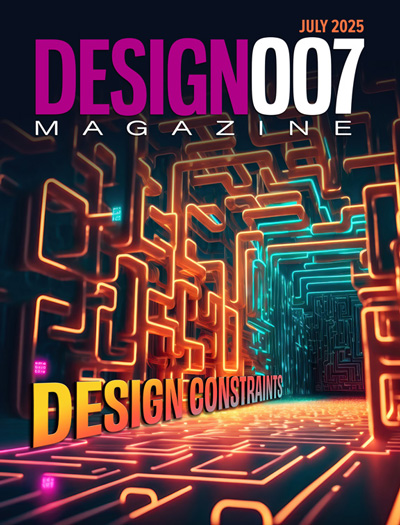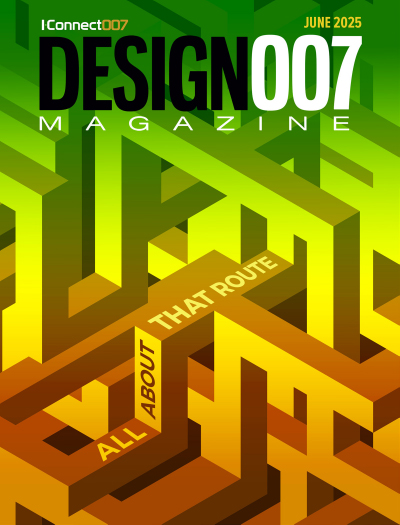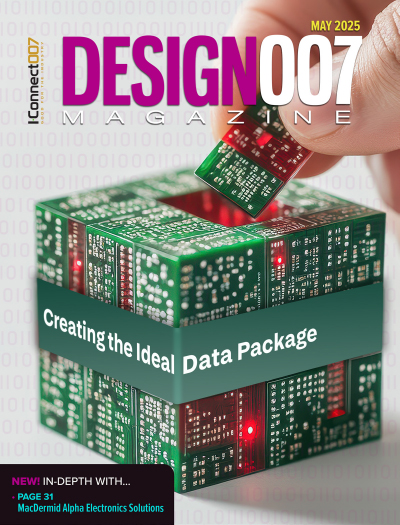-

- News
- Books
Featured Books
- design007 Magazine
Latest Issues
Current Issue
Showing Some Constraint
A strong design constraint strategy carefully balances a wide range of electrical and manufacturing trade-offs. This month, we explore the key requirements, common challenges, and best practices behind building an effective constraint strategy.

All About That Route
Most designers favor manual routing, but today's interactive autorouters may be changing designers' minds by allowing users more direct control. In this issue, our expert contributors discuss a variety of manual and autorouting strategies.

Creating the Ideal Data Package
Why is it so difficult to create the ideal data package? Many of these simple errors can be alleviated by paying attention to detail—and knowing what issues to look out for. So, this month, our experts weigh in on the best practices for creating the ideal design data package for your design.
- Articles
- Columns
- Links
- Media kit
||| MENU - design007 Magazine
Physics, Electrical Engineering, and PCB Design
December 20, 2022 | Tamara Jovanovic, Happiest BabyEstimated reading time: 2 minutes
When I was a sophomore in college, I had an amazing professor for Physics II: Electricity and Magnetism. He made a series of complex topics fun to learn, and his personality and way of teaching were almost tailor-made for the way I like to learn. He explained new concepts through practical examples, and always kept students engaged throughout the class, making sure everyone understood the lectures. Physics II was an engineering prerequisite, and I didn’t mind taking the class since I really enjoyed the material. However, I did find myself wondering a few times, “Will I ever use any physics in real life?”
It turns out that the answer to the question was yes. Through the rest of my undergrad and my master’s program, I have used physics more than just occasionally. To put it plainly, physics is essentially the study of how everything works, and it is everywhere around us. Without realizing it, we use physics while doing simple tasks around the house. The laws of physics describe everything around us, from opening a jar, using our phones, and ironing clothes, all the way to understanding how the human body works, driving a car, natural disasters, and electronics manufacturing.
Electrical engineers use the laws of physics and mathematics to convert electrical energy and power into a circuit, device, or system. Whether it’s semiconductors, circuit design, power distribution, grounding, or shielding, physics is woven through electrical design, and it helps solve complex problems even when we don’t realize it.
Any circuit board design is a process. In my job, the very first step in PCB design is board planning with mechanical engineers. There is usually a specific industrial design that is established as baseline, and we have to work around that when incorporating mechanics and electronics. We discuss critical components and parts, their size and potential location, and we make decisions on where they could be placed, as well as how specific features of the product can be implemented and executed. We also have to ensure that board shape and size can house all the components and circuits that need to be implemented. In the meantime, I start working on board schematics and design validation.
Physical strain on the PCB is another aspect of my job that involves physics. Engineers must select the optimal location for mounting and locator holes on the board. Mechanical engineers perform simulations to make sure that they aren’t putting unnecessary strain on the board and ensure the board doesn’t get damaged during assembly into the product. Once mounting hole locations are identified and the schematic is completed, an electrical/layout engineer can start working on layout.
To read this entire article, which appeared in the November 2022 issue of Design007 Magazine, click here.
Testimonial
"We’re proud to call I-Connect007 a trusted partner. Their innovative approach and industry insight made our podcast collaboration a success by connecting us with the right audience and delivering real results."
Julia McCaffrey - NCAB GroupSuggested Items
Ansys 2025 R2 Enables Next-Level Productivity by Leveraging AI, Smart Automation, and Broader On-Demand Capabilities
07/30/2025 | PRNewswireAnsys, now part of Synopsys, announced 2025 R2, featuring new AI-powered capabilities across the portfolio that accelerate simulation and expand accessibility.
Target Condition: The 5 Ws of PCB Design Constraints
07/29/2025 | Kelly Dack -- Column: Target ConditionHave you ever sat down to define PCB design constraints and found yourself staring at a settings window with more checkboxes than a tax form? You’re not alone. For many designers—especially those newer to the layout world—the task of setting up design constraints can feel like trying to write a novel in a language you just started learning.
Zuken to Showcase Defence & Security-Focused Electronic Systems Design Solutions at DSEI 2025
07/24/2025 | ZukenZuken, a global leader in electronic and electrical design automation, will showcase its latest innovations for defence and security systems at DSEI 2025, taking place at ExCeL London from 9–12 September 2025.
Creating a Design Constraint Strategy
07/24/2025 | I-Connect007 Editorial TeamMost designers learn how to set their design constraints through trial and error. EDA vendors’ guidelines explain how to use their particular tools’ constraints, and IPC standards offer a roadmap, but PCB designers usually develop their own unique styles for setting constraints. Is there a set of best practices for setting constraints? That’s what I asked Global Electronics Association design instructor Kris Moyer, who covers design constraints in his classes.
Elementary Mr. Watson: Closing the Gap Between Design and Manufacturing
07/23/2025 | John Watson -- Column: Elementary, Mr. WatsonModern PCB designers are not merely engineers or technicians. I believe that PCB design, at its core, is an art form, and modern PCB designers should be considered artists. Beyond the technical calculations and engineering rules lies a creative process that involves vision, balance, and a passion for what we do. Like any artist who works with brush and canvas or chisel and stone, a PCB designer shapes invisible pathways that bring ideas to life. Each trace, layer, and component placement reflects thoughtful decisions that blend form, fit, and function.


